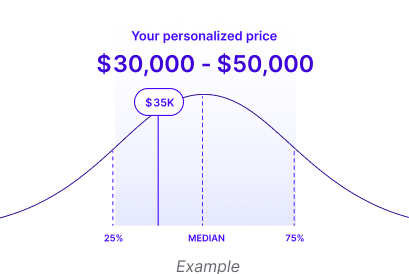Airbyte
$10,800–$100,000per year
Fast, fair, easy pricing. No sales call required.
Airbyte
|Visit airbyte.com
How much does Airbyte cost?
Median contract value
$15,000
Based on data from 9 purchases.per year
Median: $15,000
$10,800$100,000
LowHigh
See detailed pricing for your specific purchase
AI Quote Analysis
Upload your quote to check if you’re getting a fair price, under 2 minutes and completely free.

How does Airbyte price and package their products?
View pricing on Airbyte's website
Product:
Cloud
$10/monthPayment Terms: MonthlyPopular Features: 400+ connectors and automated sync scheduling
Compare prices for similar companies
| Supplier | Airbyte | Fivetran |
|---|---|---|
| Median Contract Value | $15,000 | $47,700 |
| Avg Savings | - | 17.49% |
Other companies you may be interested in
Negotiating with Airbyte
Negotiation Tips
Presenting Airbyte's competitors as viable alternatives has proven to provide leverage in negotiations. By detailing competitive offerings that match or exceed the scope of Airbyte's services at a more favorable price, you can create urgency and pressure on the vendor to match these terms. This strategy creates a clear delineation between options, emphasizing the cost and feature benefits of exploring alternatives.
Emphasizing the need to remove auto-renewal clauses in the contract can serve as a significant tactical advantage during negotiations. This maneuver ensures you retain maximum flexibility in your contract, allowing you the freedom to reassess the value of Airbyte’s services at the end of the term without being obligated to renew automatically. When you approach negotiations, make sure to express that this requirement stems from new financial protocols in place.
Highlighting expected growth in your user base can be a powerful tool in negotiations with Airbyte. By stressing that adding users will lead to greater costs, you can negotiate for lower rates that correspond to your projected increase in usage. This approach emphasizes the need for a pricing structure that scales in-line with your organization’s growth.
Leverage your previous usage reports to negotiate cost reductions effectively. If your organization did not utilize specific features or if there are discrepancies between what you're paying and your actual usage, bring those data points into the discussion. Providers are more likely to consider discounts when they see that their service is not fully utilized by the customer.
Documenting and presenting any product issues or pain points during your interactions with Airbyte can serve as leverage for negotiating additional discounts. Highlight specific instances wherein the product did not meet expectations or caused operational inefficiencies, arguing this justifies a reduction in renewal pricing to balance out the inconveniences experienced.
Considerations when buying Airbyte
OwnershipAirbyte is independently owned with a focus on open-source data integration solutions.
Fiscal year endDecember 31
Best months to buyMarch, June, December
Payment TermsMonthly invoices, Annual contracts available
Upgrades/downgradesYes, Airbyte offers both upgrades and downgrades for its services, making it easy for users to adjust their resources as their needs change.
Redline thresholdRedline threshold estimate is $20k.
Vendr community insights for Airbyte
What real buyers recommend in the negotiation process
Company with 201-1000 employeesThis month
Will only offer annual payment termsCompany with 201-1000 employeesThis year
We were in the market to leave Fivetran because our costs were way too high and unjustifiable with some of the functionality gaps of Fivetran. We trialed both Stitch and Airbyte and went with Airbyte because of their teams help (we have a unique set up). We got a 40% discount on our purchase with the ability to continue to grow into our contract at the discounted rates. We had to sign by end of month and used competition to get pricing down. Company with 201-1000 employeesA while ago
By citing budget restrictions and competitors such as Fivetran, we were able to get a 40% discount on this new purchaseCompany with 201-1000 employeesA while ago
Airbyte offers larger discounts based on volume of credits purchased. They initially offered a 35% discount for 25 daily credits, and we were able to increase that to 55% by facilitating a quick signature, allowing logo use, and leveraging finance hesitation to bring on new suppliers. Airbyte also agreed to add language guaranteeing our discount at renewal in exchange for keeping auto renew on the agreement.Additional Info
What is Airbyte?
Airbyte is an open-source data integration platform to build ELT pipelines. Consolidate your data in your data warehouses, lakes and databases.Airbyte's 4 Product
Airbyte: Cloud
Airbyte: Enterprise
Airbyte: Open Source
News that may impact Airbyte pricing or negotiations
Business Wire
Airbyte Launches Enterprise-Grade Data Connectors for Oracle Databases and WorkdayDecember 10, 2024Business Wire
Airbyte Recognized as a CRN 2024 Stellar StartupNovember 11, 2024Business Wire
Airbyte Enhances Databricks Integration Simplifying Data Movement and ConsolidationOctober 22, 2024